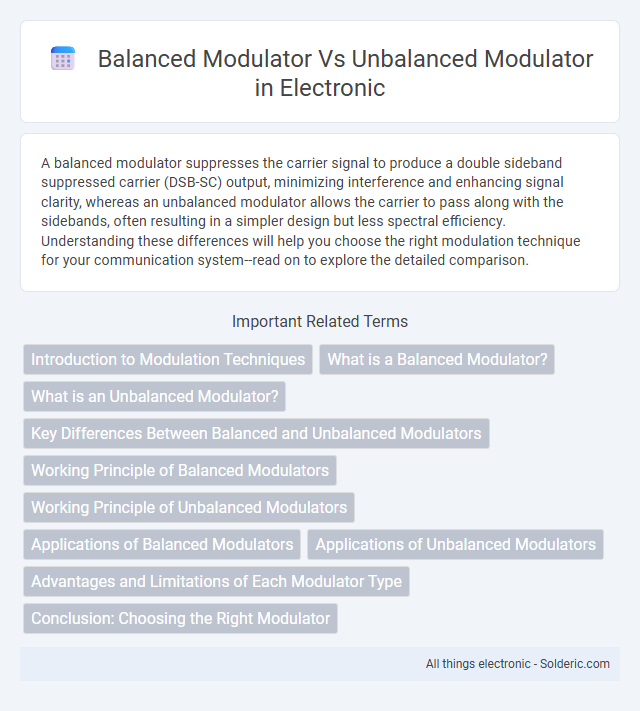A balanced modulator suppresses the carrier signal to produce a double sideband suppressed carrier (DSB-SC) output, minimizing interference and enhancing signal clarity, whereas an unbalanced modulator allows the carrier to pass along with the sidebands, often resulting in a simpler design but less spectral efficiency. Understanding these differences will help you choose the right modulation technique for your communication system--read on to explore the detailed comparison.
Comparison Table
| Feature | Balanced Modulator | Unbalanced Modulator |
|---|---|---|
| Output | Suppresses Carrier, outputs Double Sideband Suppressed Carrier (DSB-SC) signal | Includes Carrier, outputs Double Sideband Amplitude Modulated (DSB-AM) signal |
| Carrier Presence | Carrier is suppressed or minimized | Carrier is present at output |
| Complexity | More complex due to balance requirement | Simpler design and implementation |
| Applications | Used in SSB, DSB-SC systems, and noise reduction | Used in AM broadcast and simple modulation scenarios |
| Signal Efficiency | Higher efficiency by suppressing carrier power | Lower efficiency due to carrier transmission |
| Design Example | BJT or IC-based product modulators like ring modulators | Simple diode or transistor AM modulators |
Introduction to Modulation Techniques
Balanced modulators provide suppressed carrier signals by multiplying the input carrier and modulating signal, effectively reducing carrier interference and improving signal clarity in double sideband suppressed carrier (DSB-SC) modulation. Unbalanced modulators, on the other hand, allow carrier leakage, resulting in amplitude modulation (AM) with a carrier present, which makes demodulation simpler but less power-efficient. The choice between balanced and unbalanced modulators depends on the application requirements for power efficiency, signal clarity, and receiver complexity in communication systems.
What is a Balanced Modulator?
A balanced modulator is an electronic device designed to suppress the carrier signal while allowing the modulation sidebands to pass through, making it essential for generating double sideband suppressed carrier (DSB-SC) signals in communication systems. Unlike unbalanced modulators, which output both the carrier and sidebands, balanced modulators improve efficiency and reduce unwanted interference by eliminating the carrier frequency from the output. Your choice of a balanced modulator ensures clearer signal transmission and enhanced performance in amplitude modulation applications.
What is an Unbalanced Modulator?
An unbalanced modulator is a type of modulator circuit that combines the carrier and modulating signals but allows the carrier signal to appear in the output along with the sidebands. Unlike a balanced modulator, it does not cancel the carrier frequency, resulting in an output containing both the carrier wave and amplitude variations representing the modulating signal. This makes unbalanced modulators suitable for amplitude modulation (AM) applications where the carrier needs to be transmitted along with the information signal.
Key Differences Between Balanced and Unbalanced Modulators
Balanced modulators suppress the carrier signal to produce double sideband suppressed carrier (DSB-SC) output, reducing interference and improving signal clarity, whereas unbalanced modulators transmit both carrier and sidebands, resulting in a simpler but less efficient output. Key differences include the balanced modulator's ability to cancel out the carrier automatically, minimizing distortion and power loss, while unbalanced modulators allow easier implementation with higher power consumption due to carrier presence. Your choice depends on application requirements such as bandwidth efficiency, signal-to-noise ratio, and complexity of the modulation system.
Working Principle of Balanced Modulators
Balanced modulators operate by mixing two input signals, typically a carrier and a modulating signal, while suppressing the carrier frequency to produce a double sideband suppressed carrier (DSB-SC) output. They achieve this using nonlinear components arranged symmetrically, such as diodes in a ring configuration or transistor pairs, which cancel out the carrier and allow only the sideband frequencies to pass. This selective suppression enhances signal efficiency in communication systems by reducing power wastage on the carrier.
Working Principle of Unbalanced Modulators
Unbalanced modulators operate by mixing a carrier signal with a modulating signal without suppressing the carrier, resulting in an output containing the carrier, sidebands, and sometimes noise. Unlike balanced modulators, which cancel out the carrier to produce double sideband suppressed carrier (DSB-SC) signals, unbalanced modulators generate conventional amplitude modulation (AM) signals with a prominent carrier component. Their working principle involves directly multiplying the modulating signal with the carrier, making them simpler but less efficient for communication systems requiring carrier suppression.
Applications of Balanced Modulators
Balanced modulators are widely used in communications systems for generating double sideband suppressed carrier (DSB-SC) signals, crucial in amplitude modulation (AM) and single sideband (SSB) transmissions. These modulators effectively suppress the carrier frequency, improving power efficiency and reducing interference in radio transmitters and receivers. Your choice of a balanced modulator enhances signal clarity and system performance in applications like SSB voice communications and instrumentation.
Applications of Unbalanced Modulators
Unbalanced modulators are commonly used in amplitude modulation (AM) and double sideband suppressed carrier (DSB-SC) transmission systems, where simplicity and cost-effectiveness are prioritized. They find applications in audio signal processing, communication transmitters, and amplitude shift keying (ASK) in digital communication. Unbalanced modulators are suitable for scenarios requiring basic modulation without the complexity of carrier suppression.
Advantages and Limitations of Each Modulator Type
Balanced modulators provide high carrier suppression and reduce unwanted signal components, making them ideal for applications like double-sideband suppressed-carrier (DSB-SC) transmission; however, they require precise balance and complex circuitry which can increase cost and design difficulty. Unbalanced modulators are simpler and easier to implement, offering lower cost and straightforward operation, but they suffer from poor carrier suppression and generate more spurious emissions, limiting their performance in high-fidelity communication systems. The choice between balanced and unbalanced modulators depends on the required signal purity, complexity tolerance, and application-specific bandwidth constraints.
Conclusion: Choosing the Right Modulator
Balanced modulators provide superior suppression of the carrier signal, making them ideal for applications requiring high-quality amplitude modulation with minimal distortion. Unbalanced modulators are simpler and more cost-effective but allow carrier leakage, which can reduce signal clarity. Choose a balanced modulator if your project demands precise signal integrity, while an unbalanced modulator suits basic AM applications where simplicity and cost are priorities.
Balanced modulator vs unbalanced modulator Infographic

 solderic.com
solderic.com